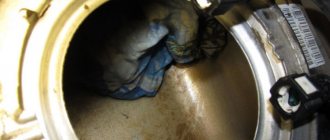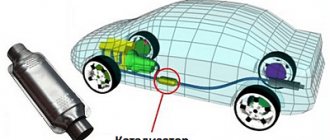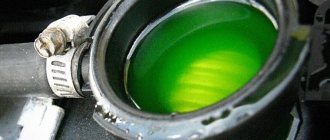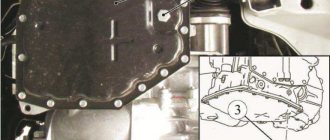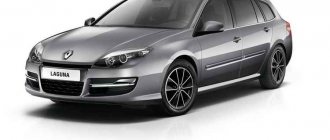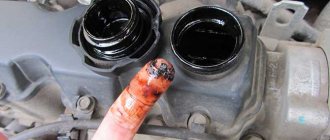Today, any car, including the Kia Sid, that uses fuel technology, cannot do without such a part as a fuel tank. Its presence allows for a short-term reserve of autonomy. Structurally, the gas tank is a sealed product that does not allow fuel to spontaneously leak out.
According to established tradition, the vast majority of manufacturers install tanks in their passenger cars in the rear seat row area. This arrangement is dictated by the desire of the developers to protect this part from serious damage in the event of an accident.
How many liters is the tank? Regarding the practical Kia Sid, we note that the volume of usable space expected to accommodate fuel in the tank, according to the manufacturer’s officially stated information, is 53 liters. This indicator allows the car to plow open roads, covering a distance of over 500 km without the need to refuel with a new portion of fuel.
During the experiments, the owners of this model came to the conclusion that as much as 65 liters can be forcibly “pumped” into the Kia Sid tank. This is the fuel volume that fits, what is called “under the neck”, and not until the effect of “shooting” the refueling nozzle appears.
The fuel tank in the “Korean” we are considering is secured using tape-type clamps. The design uses special heat-insulating inserts that prevent heating of the fuel and its subsequent expansion under the influence of high external temperatures.
Gas tank location
The Kia Rio car is designed with unconditional compliance with vehicle safety regulations. Its fuel tank is located in the most protected point of the car: near the rear of the car in the luggage compartment area.
The location of the gasoline tank is not very close to the rear bumper, approximately half a meter separates them. This distance is sufficient for the safety of people inside the car in the event of a rear collision with an obstacle or road users. A pump is installed in the car’s gas tank, which forces gasoline into the main pipelines, and an adsorber for a system for collecting emitted fuel vapors.
Fuel tank
The material for the production of a tank for a KIA Ceed car can be not only steel, but also aluminum or even plastic. In modern cars, it is the last of the three designated material options that is gaining confident popularity. Possessing fluidity, hot plastic can take any shape during production, which is convenient when using the space to install the product on the body. This explains the increase in tank volume of modern cars in comparison with models produced 2-3 decades ago. Also, this material is not subject to corrosion, which significantly increases its resource intensity.
Metal products contain welds. Each model from any manufacturer, and often modifications related to one model line, have a fuel tank that has an individual shape and unique dimensional parameters. The desire for rationalization in the use of spare space for installation forces us to lean towards this method.
Kia Rio 2004 station wagon
Crash test Kia Rio
Kia Rio radio
Specifications
The capacity of the gas tank depends on many additional factors. According to the passport data, the fuel storage capacity of the Kia Rio is 45 liters. On hot summer days, due to temperature expansion, it is not recommended to fill gasoline to capacity, that is, to the upper edge of the neck.
Taking into account safety requirements, in order to ensure sufficient thermal expansion of the medium, it is necessary to calculate an adjustment for the filling capacity of the gasoline tank.
For normal fluidity of flammable liquid, in order to meet the standard of safe transportation, only 43 liters of gasoline must be poured into the fuel tank.
Tank capacity
Volkswagen car
Jetta VI generation fuel tank capacity is on average 55 liters, including a reserve of about 7 liters. Developers, as a rule, make a small spatial reserve in the fuel tank, which will allow the car owner to fill in a little more gasoline, as they say, just in case of an emergency. However, they also warn and advise not to continue to fill the fuel tank of the Volkswagen Jetta after first turning off the fuel nozzle, since it is possible that excess fuel will be filled, which may splash and spill out, which is not safe.
rel=0;controls=0;showinfo=0;iv_load_policy=3;" frameborder=”0″ allowfullscreen>
Fuel tank volume - experiment
What is the actual volume
fuel
tank
of your car. I tried to find out personally.
On the inside of the fuel tank filler flap there is a factory sticker that indicates the type of fuel for the Volkswagen car.
Jetta On a full fuel tank, with an engine power of 105 hp. you can cover 846 km of route. Let us make a reservation that the given Jetta fuel consumption figures were derived on the basis of official directives EC 80/1268/EWG and VO (EG) 715/2007 and, as a rule, are indicative.
Basic rules for filling the fuel tank
Sooner or later, the amount of fuel in the car approaches a critical point at which a warning light lights up on the instrument panel. It notifies the driver that the reserve volume of fuel has begun to be consumed.
In order to replenish gasoline or diesel fuel and properly fill the fuel tank of a Volkswagen car
Jetta, you must adhere to the following rules:
- Before filling the fuel tank with gasoline, you must turn off the car engine;
- it is necessary to remove the car from the locking mode using the central locking button, which is located on the panel in the driver's door;
- go to the right rear of the Volkswagen Jetta, where the fuel filler
; - press the hatch on the trunk side and it will open slightly;
- open the hatch completely;
- unscrew the filler cap counterclockwise;
- hang the plug on the hatch from above and install the filling nozzle into the filler neck;
- after refueling, screw the plug in a clockwise direction until a characteristic click appears;
- close the hatch until it locks, which is also accompanied by a click;
- Check that the gas tank cap does not protrude above the body panel.
Thus, now knowing the real volume of the Volkswagen
Jetta and all aspects of its operation, as well as precautions when topping it up with gasoline or diesel, will help you get the most out of your vehicle's fuel reserves.
The content of the article:
Volkswagen Polo Sedan Silver leaf › Logbook › How much fuel will go into the tank? According to the manufacturer, the tank capacity is 55 liters. Let's try to understand the theory.
Find out how many liters are in your car's tank. Polo Sedan. Appearance. Year. Fuel tank volume. Analytics.
>>Understandable body repair of VW Polo sedan. The question is how many liters can be filled until the tank is full (not before the pistol fires). The question arose because they filled me with 31 liters!!!
All this makes this car a very interesting offer for buyers. On Sunday, at the same gas station, I filled up a full tank; it was closer to 12 at night, and I became wary that they seemed to have filled a lot. When refueling yourself, you should not try to fill the tank with more than it should be. Therefore, it is NOT recommended to pour in more, regulating that excess fuel may spill out. With the lamp burning, I filled in 68 liters.
How the fuel tank works
The Kia Rio gas tank is made of duralumin alloy. Two stamped halves are welded into a single whole - a sealed container is obtained. The device is equipped with the following products:
- fuel filler pipe;
- fuel filter;
- fastening tape;
- high pressure fuel pump;
- fuel pipe.
Many articles have been written on the Internet about tank removal, including step-by-step dismantling instructions. Brief repair recommendations are given below.
Examination
To check the tightness of the gas tank, you need to use a compressor and a hose. Having tightly closed all pipelines and holes with fittings, compressed air must be pumped into the tank. Maintain pressure of two or more atmospheres. After approximately two atmospheres, the safety valve should relieve pressure. If the plug is in good working order, the return flow will not interfere.
Sometimes the manufacturer installs a valve in the plug, but instead there may be a simple calibrated hole. In some Kia Rio models, excess pressure is released not by a plug in the gas tank, but by a special valve located on the fuel line. The tube is connected to the atmosphere, gases are released into the environment.
Repair
Leaks, damage, cracks, and holes in the fuel tank are repaired using epoxy resin or a “cold welding” kit. Epoxy resin is sold in a set with a hardener. The metal surface must be cleaned and degreased with anti-silicone.
Due to rapid setting, the two components of the material should be mixed immediately before application.
Using your fingers, knead the structure of the cold welding bar. Make a flat patch that looks like a pancake. Apply it to the damaged area and rub the edges into the metal. The gas tank can be used one hour after hardening. Cold welded material does not react with gasoline, diesel fuel, oils, and antifreeze.
How to calculate the volume of a tank made in the form of a cylinder
Similar geometric shapes are used for storing food, transporting fuel and other purposes. Many people do not know how to calculate the volume of water, but we will describe the main nuances of this process further in our article.
The height of the liquid in a cylindrical container is determined using a special device called a meter rod. In this case, the tank capacity is calculated using special tables. Products with special volume measurement tables are rare in life, so let’s approach the problem in a different way and describe how to calculate the volume of a cylinder using a special formula - V=S*L, where
- V is the volume of a geometric body;
- S – cross-sectional area of the product in specific units of measurement (m³);
- L is the length of the tank.
The L indicator can be measured using the same tape measure, but the cross-sectional area of the cylinder will have to be calculated. The S indicator is calculated using the formula S=3.14*d*d/4, where d is the diameter of the cylinder circumference.
Now let's look at a specific example. Let's say the length of our tank is 5 meters, its diameter is 2.8 meters. First, let's calculate the cross-sectional area of the geometric figure S = 3.14 * 2.8 * 2.8/4 = 6.15 m. And now you can start calculating the volume of the tank 6.15 * 5 = 30.75 m³.
Of course, drivers most often do not allow the gasoline light to come on in the car, which warns of low fuel level in the tank. This warning indicates that it is time to refuel the vehicle. But should we immediately go to the gas station and refuel the car as soon as possible? How much longer do we have before our car runs out of petrol or diesel? Here is a detailed table for many car models that details how much fuel is left in the tank after a low petrol or diesel warning appears on the dashboard.
The table published below provides approximate values for a particular car model. Please note that the data is provided for cars manufactured up to 2020 inclusive. Also keep in mind that some values in the table may differ slightly from actual values.
But on average, the following values are obtained: passenger cars, after the fuel level light in the tank comes on, can still travel about 50 kilometers, while SUVs and crossovers, which usually have an increased volume of fuel tanks, can drive with the fuel light on approximately another 150 kilometers.
Does this mean that car owners may not rush to the gas station when they see a low fuel warning on their dashboard? Of course not. Especially if you are in an unfamiliar area and have no idea how far the next one will be.
That is, despite the fact that in any car the fuel tank has a certain reserve of fuel, after the warning lamp appears, indicating a low fuel level in the tank, you should refuel your car as soon as possible and next time do not allow this warning to appear again. Always keep the fuel level in the tank until the fuel light appears on the dashboard.
